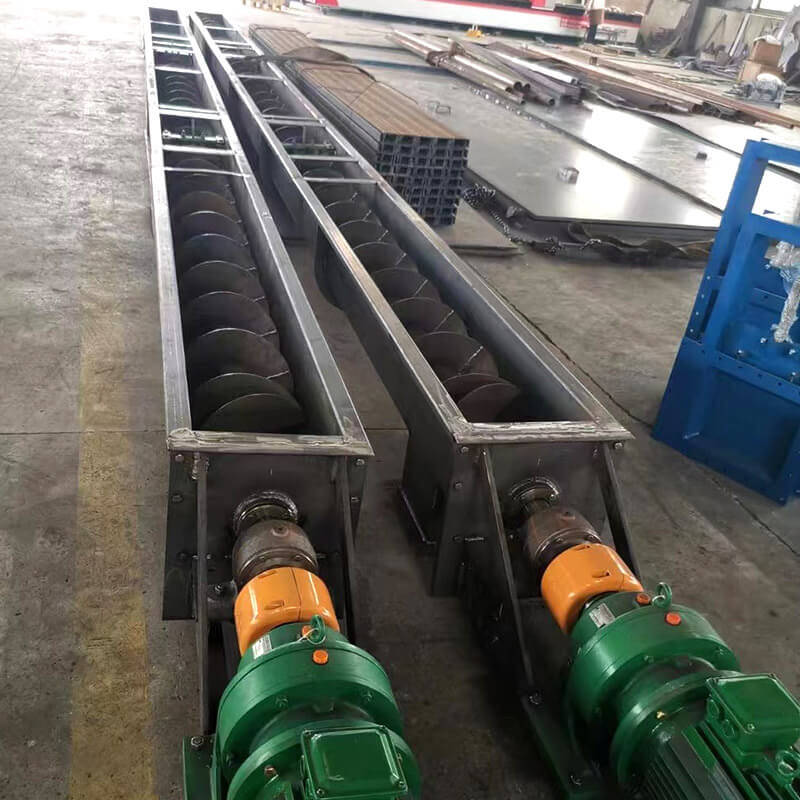¿Qué es un transportador sinfín?
A transportador de tornillo (también llamado transportador sinfín) es un sistema mecánico utilizado para mover materiales a granel con eficacia. El Transportador de tornillo LS es un popular modelo industrial diseñado para el transporte horizontal o ligeramente inclinado. A diferencia de una cinta transportadoraque utiliza una cinta móvil, una transportador de tornillo se basa en una cuchilla helicoidal giratoria (tornillo) para empujar los materiales hacia delante.
Diferencias clave entre el transportador de tornillo sinfín y el transportador de banda:
✔ Transportador de tornillo:
Totalmente cerrado, lo que evita el polvo y la contaminación
Mejor para polvos, gránulos y grumos pequeños
Maneja pendientes más pronunciadas (hasta 45° con un diseño especial)
Menor mantenimiento pero mayor consumo de energía
✔ Cinta transportadora:
Abierto o cerrado, mejor para materiales grandes y pesados
Mayor capacidad de transporte a larga distancia
Menor degradación del material (sin efecto de aplastamiento del tornillo)
Requiere más espacio y ajustes frecuentes de la correa
¿Qué es un transportador de tornillo LS? Funciones principales y principio de funcionamiento
El transportador de tornillo LS (también llamado alimentador de tornillo) es una máquina industrial muy utilizada para el transporte de materiales en polvo, granulados y pequeños terrones. "LS" significa "Screw" (tornillo) y "Level" (nivel) de transporte. Como equipo esencial en las líneas de producción modernas, funciona mediante la rotación de paletas en espiral para empujar los materiales a través de un tubo, lo que permite un transporte eficaz y continuo.
Especificaciones detalladas:
Gama de diámetros: De 100 mm a 1250 mm (los modelos estándar incluyen 100, 160, 200, 250, 315, 400, 500, 630, 800, 1000 y 1250 mm)
Longitud de una unidad: Hasta 35 m (máx. 30 m para los modelos LS1000 y LS1250)
Temperatura de funcionamiento: -20°C a 50°C ambiente, manipula materiales ≤200°C
Ángulo de inclinación: Mejor por debajo de 20°, diseños especiales hasta 45
7 Ventajas clave: ¿Por qué elegir un transportador de tornillo LS?
Diseño compacto: Ahorra espacio, ideal para diseños de fábrica ajustados
Múltiples puntos de carga y descarga: Permite la transferencia de material en varias posiciones (término profesional: puertos intermedios de alimentación/descarga)
Transporte totalmente cerrado: Evita las fugas de polvo, cumple las normas medioambientales (palabra clave: transportador sinfín a prueba de polvo)
Bajos costes de mantenimiento: Más sencillas y baratas que las cintas transportadoras
Opciones de material: Acero al carbono, acero inoxidable (304/316), opciones de calidad alimentaria y resistentes a la corrosión
Características personalizables: Motores antideflagrantes, variadores de velocidad, módulos de pesaje
Instalación flexible: Configuraciones horizontales, inclinadas o verticales
Aplicaciones industriales: ¿Qué materiales funcionan mejor?
Materiales ideales:
Polvos: Cemento, harina, polvo de carbón, talco
Granulados: Granos, gránulos de plástico, abono
Pequeños terrones: Carbón triturado, piedras pequeñas, pellets de biomasa
No recomendado para:
Materiales perecederos (por ejemplo, algunos ingredientes alimentarios)
Sustancias de alta viscosidad (por ejemplo, asfalto, jarabe)
Materiales aglutinantes (por ejemplo, ciertos productos químicos)
Grumos grandes (diámetro > 1/4 del tamaño del tornillo)
Guía de compra: 5 factores críticos de decisión
Análisis de materiales: Densidad, humedad, fluidez, abrasividad
Cálculo de la capacidad: Seleccione el modelo en función de las toneladas/hora necesarias
Distancia de transporte: Una sola unidad máx. 35 m, conecte varias para tramos más largos
Condiciones especiales: A prueba de explosiones, impermeable, necesita altas temperaturas
Saldo presupuestario: Compare el coste inicial con los gastos de funcionamiento a largo plazo
Reglas de instalación: 10 pasos para obtener el mejor rendimiento
Prepare los cimientos: Complete la base de hormigón con 20 días de antelación
Compruebe las piezas: Verifique que todos los componentes estén presentes y limpios
Alinee las líneas centrales: Garantice un posicionamiento horizontal/vertical adecuado
Uniones lisas: Mantenga las superficies de unión dentro de una diferencia de altura de 1 mm
Asegure la base: Apriete con pernos de alta resistencia
Calibre los rodamientos: Apoye correctamente los cojinetes del soporte intermedio
Apriete todos los tornillos: Aplique las especificaciones de par de apriete correctas
Lubrique los sistemas: Compruebe los niveles de aceite de la caja de cambios y los cojinetes
Prueba en vacío: Funcionamiento sin material durante más de 4 horas
Comprobación de seguridad: Instale los topes de emergencia y las cubiertas protectoras

Funcionamiento y mantenimiento: Consejos de expertos para prolongar la vida útil
Funcionamiento diario:
Secuencia de arranque: Encendido en vacío, luego alimentar el material gradualmente (palabra clave: procedimientos de funcionamiento del transportador sinfín)
Proceso de parada: Limpiar todo el material antes de parar
Control de la alimentación: Utilice un alimentador vibratorio para una alimentación constante
Protección contra objetos extraños: Añada rejillas en la entrada
Calendario de mantenimiento:
| Nivel | Tiempo de ejecución | Duración | Tareas clave |
|---|---|---|---|
| Diario | Por turno | 10 min | Limpiar, apretar, lubricar comprobar |
| Nivel 1 | 720 horas | 4 horas | Inspección completa, sustitución de las piezas desgastadas |
| Nivel 2 | 2400 horas | 16 horas | Revisión del sistema, sustitución de cojinetes |
Solución de problemas:
Ruidos extraños: Compruebe si hay desgaste de los cojinetes u objetos atascados
Capacidad reducida: Inspeccione el desgaste de las cuchillas o la potencia del motor
Fugas de material: Examine el deterioro de las juntas
Estudio de caso: Implantación de la fábrica de Darko
Dos transportadores de tornillo LS400 han funcionado de forma fiable durante 3 años en la fábrica de Darko, logrando:
Transporte continuo de cemento a 60 toneladas/hora
Control del polvo conforme a la norma ISO 14644-1 Clase 7
25% menor consumo de energía frente a los sistemas tradicionales
Comparación técnica: LS frente a otros transportadores
| Característica | Transportador de tornillo | Cinta transportadora | Elevador de cangilones |
|---|---|---|---|
| Sellado | ★★★★★ | ★★☆☆☆ | ★★★★☆ |
| Espacio necesario | ★★★★☆ | ★★☆☆☆ | ★☆☆☆☆ |
| Mantenimiento | ★★☆☆☆ | ★★★☆☆ | ★★★★☆ |
| Coste | ★★★☆☆ | ★★☆☆☆ | ★★★★☆ |
| Ángulo máximo | <20° | <30° | Vertical |
Preguntas y respuestas de expertos: Las 8 preguntas más frecuentes de los clientes
P: ¿Cómo calcular la capacidad necesaria del modelo?
R: Utilice la fórmula Q=47D²nψρC (diámetro D, velocidad n, índice de llenado ψ, densidad ρ, factor de ángulo C).
P: ¿Cuánto más caro es el acero inoxidable?
R: Normalmente 30-50% mayor coste pero dura 2-3 veces más
P: ¿Pueden fabricar tamaños no estándar?
R: Sí, mínimo 100 mm de diámetro, máximo 1500 mm
P: ¿Qué tienen de especial los modelos a prueba de explosiones?
R: Utilizan motores a prueba de explosiones, conexión a tierra y cuchillas antiestáticas.
P: ¿Cómo reparar las cuchillas desgastadas?
A: Aplique una soldadura resistente al desgaste o sustitúyala por cuchillas de aleación
P: ¿Ventajas frente a los transportadores tubulares de arrastre?
A: Estructura más sencilla, mantenimiento más fácil, mejor para distancias medias-cortas
P: ¿Qué certificaciones de calidad alimentaria existen?
R: Proporcionamos normas sanitarias FDA, CE y 3A.
P: ¿Cantidad mínima de pedido y plazo de entrega?
R: 1 unidad para modelos estándar (15-30 días), 45-60 días para personalizados
El transportador de tornillo LS es un eficaz dispositivo de manipulación de materiales. Con una instalación, funcionamiento y mantenimiento adecuados, puede maximizar el rendimiento y garantizar un funcionamiento estable a largo plazo. Para más información o consultas, por favor Contacto. Estamos dispuestos a proporcionarte apoyo y servicios profesionales.

